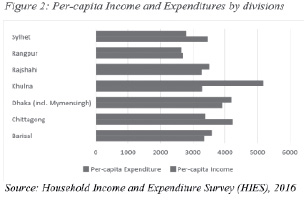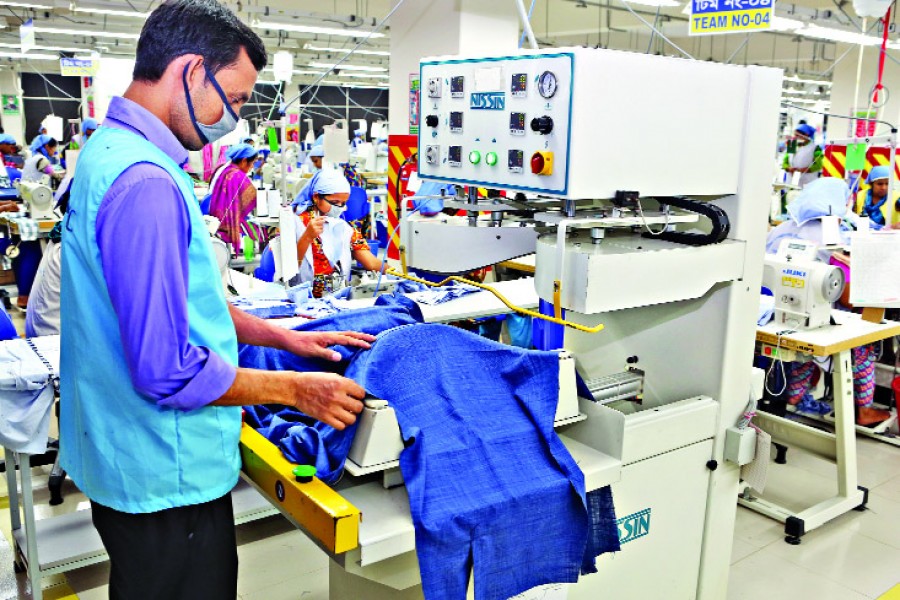Bangladesh has made considerable progress by achieving economic growth rate of 7.85 per cent during FY 2018. However, the country still needs to generate 2 million jobs every year to accommodate new entrants to its labour force. More than 40 per cent of the workforce is still in agriculture, whose share in the national economy is quite small (15 per cent) and is set to shrink further. The country also suffers from a huge underemployment problem, which means that non-farm activities in the urban areas will have to absorb the influx of labour from agriculture. According to the Harris-Todaro growth model, people migrate to the cities as long as their expected income is higher. The main assumption of the model is that migration decision is based on expected income differentials between rural and urban areas rather than just wage differentials. However, in the case of Bangladesh as per Labour Force Survey (LFS) 2017, there has been an urban-rural wage convergence-- such that the wage premia for urban jobs is markedly low, about 15 per cent in nominal terms. Expected urban wage premia is even lower. In addition, the manufacturing-agriculture wage differentials have collapsed, to the extent that the manufacturing sector is unable to pull the surplus agricultural labourers. Thus, the rural-urban migration of the work force in our country tends to be the result of "push-factor" rather than the "pull-factor" as suggested by the Harris-Todaro growth model.
Nevertheless, the majority of the people moving to the cities due to forced migration of climate change, loss of arable land, river erosion etc find it harder to get jobs in the formal sector. As a result, they engage themselves in informal jobs for survival in a very low or insufficient payment structure. According to LFS 2017, of the total 60.8 million employed population, 85.1 per cent are engaged in low productivity informal employment. Lack of proper education and technical skills constraints formal employment for the new migrants. Unemployment and mostly underemployment thus poses serious threat to the economic development of the country at the moment.
FALL IN REAL WAGES: While employment growth has largely been flat at 2 per cent per annum in the recent years, there has been a deceleration of real wages and earnings, especially for workers whose earnings fall in the middle of the wage spectrum. During 2013 and 2017, the average nominal wage of an employed person rose from 11493 BDT to 13258 BDT, which is 15.3 per cent increment in 5 years. The inflation rate during these years was 5 to 6 per cent per year; so there has been a deterioration of wages for the workers in real terms. One important reason can be the supply of labour is more than the demand for labour in the low-skilled jobs, for which their real income deteriorates. This suggests that unless the economy performs better in enhancing workers' productivity at much faster rate, wage and earning potentials could get depressed with rise in unemployment rate.


PER-CAPITA INCOME AND EXPENDITURE: Even though a worker is earning around 13000 BDT per month, his/her wage is shared among 4 or 5 other household members due to large number of dependents (both young and elderly people). The state provides very trivial amount of old-age benefits or child allowances, so it's usually the responsibility of the income-earners to provide for his/her family. Not only that, the number of working poor has increased considerably during the last five years. Low paying, relatively unproductive informal sector jobs continue to dominate labour markets. This highlights the continued importance of job quality as an issue since most of the labour force continues to remain in the informal sector, working in relatively low efficiency jobs.
In some parts of the country, such as Sylhet and Rangpur, per-capita expenses are more than income, which shows that people in those areas are living way below the poverty line. Even if there is the possibility of flawed data in HIES 2016, there is no doubt that many Bangladeshi workers are trapped in jobs with low earnings and surviving on very low maintenance. Also, female labour force participation rate is very small, 36.8 per cent in 2017, as most of the women in the rural areas are involved in unpaid family work. Being a developing country aspiring to become a middle-income and high-income country by 2031 and 2041 respectively, Bangladesh has still 24.3 per cent of its people living below the upper poverty line and 12.9 per cent in extreme poverty. The overarching challenge is to increase the earnings of 109 million working-age population, especially the working poor, while meeting the demand for jobs by the new entrants.
WAY FORWARD: Bangladesh has made great strides in industrialisation, urbanisation and economic diversification. However, there is no better way to lift people out of poverty than productive employment. Rising labour income helps lessen poverty. Rapid industrialisation triggers mass exodus of people to towns and cities and into works in factories and firms, raising factor productivity. There is no doubt that the government has taken various initiatives to lessen productivity gaps among regions by improving basic education and skills.
On the contrary, widespread economic informality (both unregulated transactions and untaxed markets) is crucial for understanding the growing concerns about work and well-being of the workers. Formalisation of work is necessary in order to increase the coverage of essential work risk and social protection and to sustain growth. A large portion of the labour force in Bangladesh works without any formal labour contract and thus continues to work beyond the reach of taxation, regulation and protection. Rapid urbanisation is changing the composition of employment, yet without altering the workers' earning capacity. Urban relative wages were on average 37 per cent higher than rural wages in nominal terms as per LFS 2017. Real wage premia is much lower. This is exceptionally low by international standards.
Job growth reflects acceleration in economic growth and rise in self-employment. Sending workers abroad or opening up opportunities in the international markets helps to bring substantial remittances. Around 0.9 million workers migrated abroad during FY2018 and sent remittances amounting to USD 3.39 billion. In FY 2019 (up to September 2018), 0.16 million labour force moved overseas. Bangladesh Bureau of Manpower Employment and Training (BMET) regularly conducts both informal and specialised training as well as assists in emigration clearance for the migrant workers and their families. Further facilitating actions will encourage more migrants in the coming years.
Given the trends of production technologies, export diversification is perhaps more important than ever. Automation might affect all labour-intensive manufacturing exports, but an expanded range of production activities can generate new jobs. Technological progress has historically hurt certain group of workers (unskilled ones more often) while benefiting others leading to income inequality. The potential impact on women is going to be a particularly important issue for Bangladesh. Policies that focus on progressive tax systems, might call for addressing the problem.
Finally, investment in health, education and technical education (those relevant for specific jobs) in Bangladesh remains far from satisfactory and needs to be highly emphasised. Careful policy attention to these sectors will play an important role in generating future jobs and development of human capital.
Nuzat Tasnim Dristy is Senior Research Associate, Policy Research Institute (PRI), Bangladesh.


